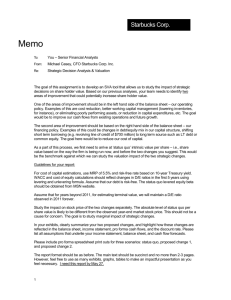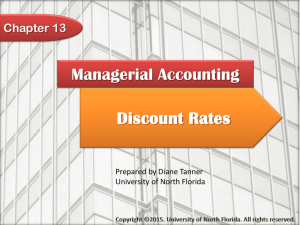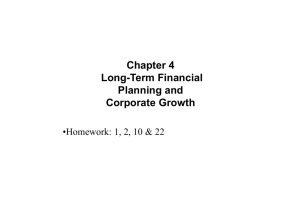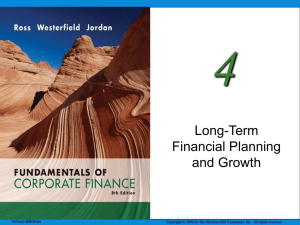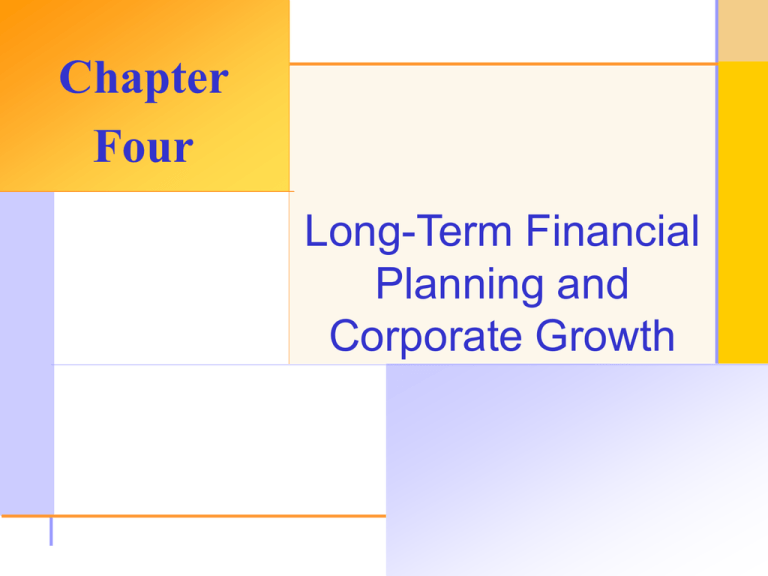
Chapter
Four
Long-Term Financial
Planning and
Corporate Growth
© 2003 The McGraw-Hill Companies, Inc. All rights reserved.
4.1
Key Concepts and Skills
Understand the financial planning process and
how decisions are interrelated
Be able to develop a financial plan using the
percentage of sales approach
Understand the four major decision areas
involved in long-term financial planning
Understand how capital structure policy and
dividend policy affect a firm’s ability to grow
4.2
Chapter Outline
What is Financial Planning?
Financial Planning Models: A First Look
The Percentage of Sales Approach
External Financing and Growth
Some Caveats On Financial Planning Models
4.3
What is Financial Planning
“Planning is a process that, at best,
helps the firm to avoid stumbling
into the future backwards”
Source: Member, Board of Directors, General
Motors Corporation
A Financial Plan is a statement of
what is to be done in the future
4.4
Basic Elements of Financial Planning
Investment in new assets – determined by capital
budgeting decisions
Degree of financial leverage – determined by capital
structure decisions
Cash paid to shareholders – dividend policy
decisions
Liquidity requirements – determined by net working
capital decisions
4.5
Financial Planning Process 4.1
Planning Horizon - divide decisions into short-run decisions
(usually next 12 months) and long-run decisions (usually 2 – 5
years)
Aggregation - combine capital budgeting decisions into one
big project
Assumptions and Scenarios
Make realistic assumptions about important variables
Run several scenarios where you vary the assumptions by reasonable
amounts
Determine a worst case, normal (base) case and best case scenario
4.6
Role of Financial Planning
Examining interactions – helps management see the
interaction between the investment & financing decisions
Exploring options – gives management a systematic
framework for exploring its opportunities
Avoiding surprises – helps management identify possible
negative outcomes and plan accordingly
Ensuring Feasibility and Internal Consistency – helps
management determine if goals can be accomplished and if
the various stated (and unstated) goals of the firm are
consistent with one another
Communication with investors & lenders – a financial plan
ensures all stakeholders have a clear picture of the firm’s
intended strategy
4.7
Financial Planning Model Ingredients 4.2
Sales Forecast – many cash flows depend directly on the level
of sales (often estimated using a growth rate in sales)
Pro Forma Statements – setting up the financial plan in the
form of projected financial statements allows for consistency
and ease of interpretation
Asset Requirements – what additional fixed assets will be
required to meet sales projections
Financial Requirements – how much financing will we need
to pay for the required assets
Plug Variable – management decision about what type of
financing will be used (makes the balance sheet balance)
Economic Assumptions – explicit assumptions about the
expected economic environment (interest rates, tax rates &
sales growth targets)
4.8
Example 1 – Historical Financial Statements
Assets
Computerfield Corp
Computerfield Corp
Balance Sheet
December 31, 2005
Income Statement
For Year Ended
December 31, 2005
500
Debt
250
Revenues
Total
500
Equity
250
Total
500
1,000
Costs
800
Net Income
200
4.9
Example 1 - Pro Forma Income Statement
Initial Assumptions
Revenues will grow at 20%
All items are tied directly to
sales and the current
relationships are optimal
Consequently, all other items
will also grow at 20%
Computerfield Corp
Pro Forma Income Statement
For Year Ended 2006
Revenues
1,200
Costs
960
Net Income
240
4.10
Example 1- Pro Forma Balance Sheet
Computerfield Corp
Pro Forma Balance Sheet
Case 1
Assets
600 Debt
Equity
Total
600 Total
300
300
600
Assumptions:
Since revenues grew by
20%, all other variables
also increase by 20%
Problem: Net income
grew by $240 but Equity
on the B/S only grew by
$50. How can we
reconcile this?
Solution: Computerfield
must have paid out a
dividend of $190
4.11
Alternative Solution
Computerfield Corp
Pro Forma Balance Sheet
Assets
Case 1I
600 Debt
Equity
Total
600 Total
Assumptions:
Revenues & profits
grow by 20% but no
dividends are paid.
110
490
600
Problem: Equity on the
B/S grows by 240, the
full amount of net
income. How can we
reconcile this?
Solution: Computerfield
must have paid down its
debt by $140.
4.12
Percent of Sales Approach 4.3
Some items tend to vary directly with sales, while others do
not
Income Statement
Costs may vary directly with sales
If this is the case, then the profit margin is constant
Dividends are a management decision and generally do not vary
directly with sales – this affects the retained earnings that go on the
balance sheet
Balance Sheet
Initially assume that all assets, including fixed, vary directly with sales
Accounts payable will also normally vary directly with sales
Notes payable, long-term debt and equity generally do not vary with
sales because they depend on management decisions about capital
structure
The change in the retained earnings portion of equity will come from
the dividend decision
4.13
Example 2 – Percentage of Sales Method
Rosengarten Corp
Rosengarten Corp
Income Statement, 2005
Pro Forma Income Statement, 2006
% of Sales Sales
1,250
Sales
1,000
Costs
1,000
250
Costs
800
80% EBT
Taxes
85
EBT
200
20%
Net Income
165
Taxes (34%)
68
6.8%
Dividends
55
Net Income
132
13.2%
Add. To RE
110
Dividends
44
Add. To RE
88
Dividend Payout Rate = 33.3%
Assumptions: Sales grow at 25%. Total
costs are equal to 80% of sales. The
dividend payout ratio remains constant at
33.3%. The retention ratio is 66.67%
4.14
Example 2 – Percentage of Sales Method
Rosengarten Corp– Balance Sheet
Current
% of
Sales
Pro
Forma
ASSETS
Current Assets
Current
% of
Pro
Sales Forma
LIABILITIES & OWNERS’ EQUITY
Current Liabilities
Cash
$160
16%
$200 A/P
A/R
440
44%
550 N/P
100
n/a
100
Inventory
600
60%
750
Total
400
n/a
475
1,500 LT Debt
800
n/a
800
800
n/a
800
1,000
n/a
1,110
1,800
n/a
1,910
Total
1,200 120%
$300 30%
$375
Owners’ Equity
Fixed Assets
Net PP&E
1,800 180%
2,250
C Shares
Total Assets
3,000 300%
3,750
RE
Total
Total L & OE
Capital intensity Ratio
3,000
3,185
4.15
Example 3 – External Financing Needed
Problem: The Balance Sheet does not balance. The
firm needs to raise another $565 in either debt or
equity. This is the external financing needed
(EFN).
The firm can only grow sales by 25% if it can raise
an additional $565 in debt or equity.
Four possible solutions ($565 of new debt and/or
equity is required):
Borrow more short-term (Notes Payable)
Borrow more long-term (LT Debt)
Sell more common shares (C Shares)
Decrease dividend payout, which increases Additions To
RE
4.16
Example 4 – Operating at Less than Full Capacity
The previous scenario assumed the firm was operating at
100% of capacity
Suppose that the company is currently operating at only 70%
of capacity.
Full Capacity sales = 1,000 / .70 = 1,429
Estimated sales = $1,250, so would still only be operating at 87.5% of
capacity
Therefore, no additional fixed assets would be required.
Pro forma Total Assets = $3,300
Total Liabilities and Owners’ Equity = 3,185
Four solutions ($115 of new debt and/or equity is required):
Borrow short term (increase Notes Payable)
Borrow long-term debt (increase LT Debt)
Sell Common Shares
Pay less in dividends (increase Additions To RE)
4.17
Growth and External Financing 4.4
Fast growth usually requires significant external financing,
thereby making fast growing firms potentially risky
At low growth levels, internal financing (retained earnings)
may exceed the required investment in assets
As the growth rate increases, internal financing will not be
enough and the firm will have to go to the capital markets for
money
Examining the relationship between growth and external
financing required is a useful tool in long-range planning
4.18
The Internal Growth Rate
The internal growth rate tells us how much the
firm can grow assets using retained earnings as
the only source of financing.
ROA Plowback
Internal Growth Rate
1 - ROA Plowback
Where:
ROA = Return on Assets
Plowback = 1 – Payout Ratio
Payout Ratio = Dividends/Net Income
4.19
The Sustainable Growth Rate
The sustainable growth rate tells us how much
the firm can grow by using internally generated
funds and issuing debt to maintain a constant
debt ratio.
Sustainable Growth Rate
Where:
ROE Plowback
1-ROE Plowback
ROE = Return on Equity
Plowback = 1 – Payout Ratio
Payout Ratio = Dividends/Net Income
4.20
Example:
A firm has a ROA of 5%, a retention rate of 40% and a ROE
of 15%. What is the firm’s internal growth rate and what is
its sustainable growth rate?
ROA Plowback
1 - ROA Plowback
0.05 0.40
1 - .05 .40
2.04%
Internal Growth Rate
ROE×Plowback
1 - ROE×Plowback
0.15×0.40
=
1 - .15×.40
=6.38%
Sustainable Growth Rate =
4.21
Determinants of Growth
The Du Pont identity tells us that ROE can be
written as follows:
ROE Profit Margin Total Asset Turnover Equity Multiplier
From this, we can deduce that growth depends on:
Profit margin – operating efficiency
Total asset turnover – asset use efficiency
Financial policy – choice of optimal debt/equity ratio
Dividend policy – choice of how much to pay to
shareholders versus reinvesting in the firm
4.22
Some Caveats 4.5
It is important to remember that we are
working with accounting numbers and ask
ourselves some important questions as we go
through the planning process
How does our plan affect the timing and risk of
our cash flows?
Does the plan point out inconsistencies in our
goals?
If we follow this plan, will we maximize owners’
wealth?
4.23
Quick Quiz
What is the purpose of long-range planning?
What are the major decision areas involved in
developing a plan?
What is the percentage of sales approach?
How do you adjust the model when operating
at less than full capacity?
What is the internal growth rate?
What is the sustainable growth rate?
What are the major determinants of growth?
4.24
Summary 4.6
You should understand:
The financial planning process and how key
financial decisions are interrelated
How to use the percentage-of-sales method to
make a financial plan
How to adjust the model if the company is
operating under-capacity
How to calculate both the internal growth rate and
the sustainable growth rate
The factors that determine growth



